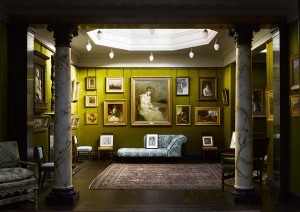—>Andrea’s trip to some stately mansions in England brings up issues of art, architecture and British aesthetics.—the Artblog editors————>
I had a wonderful time visiting three historic houses in and near London. Each was unconventional in its day and the product of its owner/designer’s passion for the past. Two hold significant places in the history of British aesthetics.
A Neo-Palladian Gem
Richard Boyle, Third Earl of Burlington (1694-1753) was an amateur architect who designed Chiswick House with the aid of professionals, including William Kent, who is responsible for its splendid gardens. Burlington intended to restore the ideals of Classical Roman architecture embodied in the work of Andrea Palladio (1508-80, who became important in the U.S. through Thomas Jefferson’s buildings at Monticello in the 1760s and his later buildings at the University of Virginia).
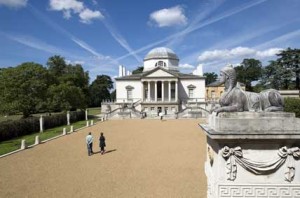
Chiswick House, completed in 1729, is not the earliest example of British Neo-Palladian architecture, but was certainly one of the most influential and widely considered the best example in London. It was built as an aesthetic exercise, sited on the grounds of Burlington’s country estate just West of London (his city residence, Burlington House, now houses the Royal Academy). A pavilion for entertaining, it lacked the practical features of a residence, such as a kitchen. But the house is an exquisitely-rendered version of an ideal type. Visiting the house and walking through its gardens made for a delightful morning trip.

Burlington designed the building to impress visitors of highly-educated taste who would appreciate its sequence of rooms of varying, geometric designs, and the allusions to architectural history in its details. According to one of the very good explanatory texts provided in the house, visitors would have recognized that a frieze above an interior door represented the story of the origin of the Corinthian order, when acanthus leaves grew out of a basket on a young girl’s grave.
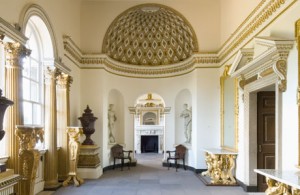
Kent’s gardens at Chiswick were also intended as recreations of Roman ideals, and are among the earliest examples of the English style of landscape gardening, which contrasted sharply with the formality of French parterres. They include architectural and sculptural elements (including a gate by the 17th century English architect who first looked to Roman ideals, Inigo Jones) within a seemingly-natural setting. Influenced by the 17th-century paintings of Claude and Poussin, such assymetrical and casual-looking English gardens had a major impact on gardens across Europe. One example is the English style garden at the castle of Wilhelmshohe, which I visit every five years when Documenta is held at Kassel.
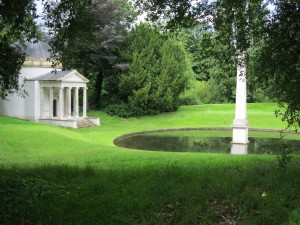
The Original Haunted House: Horace Walpole’s Strawberry Hill
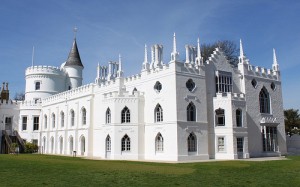
The most dramatic rejection of Burlington’s Neo-Classical ideals was certainly Strawberry Hill, the house that begat the horror story. Horace Walpole began building his country home in 1748 on the banks of the Thames in Twickenham, now a London suburb West of Chiswick, but then decidedly countryside. The son of Britain’s first Prime Minister, Walpole is known for his letters (48 volumes, and not all were published), which give an extraordinary social picture of the period. He was one of the great, eccentric characters of his day. His school friend, Thomas Grey, wrote a famous poem commemorating Walpole’s beloved cat, Selima, who drowned while attempting to catch goldfish.
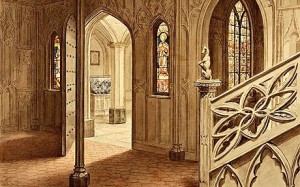
Strawberry Hill is an imaginative and theatrical rather than historical evocation of Medieval architecture, its Gothic stonework executed in wood, paper mache and illusionistic, painted wallpaper. Walpole drew inspiration wherever he found it; his painting gallery (later a ballroom) was based upon part of Westminster Abbey and he based fireplace surrounds on wall tombs. He predicted: My buildings are paper…and will be blown away in ten years after I am dead. How wrong he was. While the house has had a decidedly-checkered past, both house and garden are currently undergoing very expensive and scrupulous restoration and is great fun to visit, with a very good restaurant instead of the more usual, basic cafe.
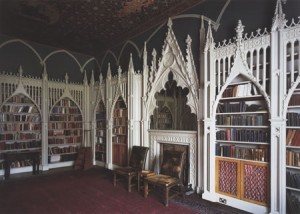
Walpole was also author of the first Gothic novel, The Castle of Otranto, which he acknowledged was inspired by a dream set in Strawberry Hill. The book influenced Mary Shelley, Edgar Allen Poe and all subsequent writers of the macabre.
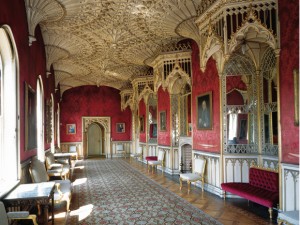
Strawberry Hill became the object of so much curiosity that Walpole wrote a guidebook for the many, uninvited visitors who came to view his small capricious house…. built to please my own taste, and in sole degree to realize my own vision. His housekeeper supposedly made money on the side by charging the visitors for tours. More than 250 years later his fantasy castle is still a charming vision. Walpole’s interest in Gothic architecture was far ahead of the times, but would be enthusiastically taken up in the Nineteenth Century.
An Aesthetic Movement Artist’s House
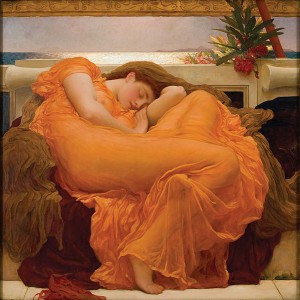
Frederick Leighton is little known today and I’m not sure any of his work is on view in a U.S. museum, although the late Robert Rosenblum used his painting, Flaming June, on the cover of his 1984 revisionist survey, Nineteenth-Century Art. Leighton was one of the most successful artists of his time, president of the Royal Academy of Arts and the first artist to be elevated to the peerage. Leighton House (1864-96), in the Holland Park area of West London, offers a fascinating look at the showcase of a successful artist who wished to impress his clients.
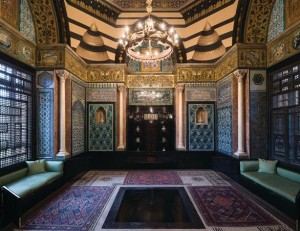
Leighton’s house is as imaginary a pastiche as Strawberry Hill, with an even greater variety of sources. My favorites are the entry hall, with a Pompeian floor and a filigree Turkish wedding-chest built as a seat into a stair landing, and the spectacular Arab Hall (1877), where Leighton combined a thousand 17th century Iznik tiles with bits and pieces of Egyptian woodwork, a modern chandelier, and additional decorations by William de Morgan and Walter Crane. Yet it forms a remarkably-unified, if fantastical, atmosphere – a poetic, English translation of the Arabian Nights. A fountain provides the aural background for a room with banquettes for lounging and lattice-work covering the windows, screening the little sun available in London.
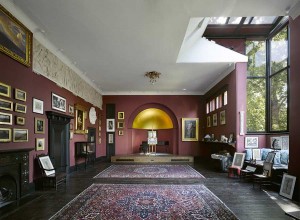
Leighton’s studio is one Jeff Koons might aspire to: the entire width of the house, with huge, North-facing windows that look onto a lovely garden. It is decorated with red walls, casts of the Parthenon marbles, and Leighton’s sketches from life and from a wide variety of artistic precedents. His almost-monastic bedroom, with its simple, single bed, is the only room dedicated for sleeping.
